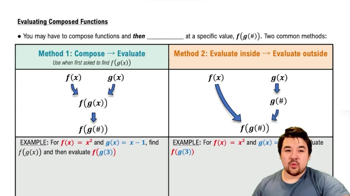Table of contents
- 0. Functions7h 52m
- Introduction to Functions16m
- Piecewise Functions10m
- Properties of Functions9m
- Common Functions1h 8m
- Transformations5m
- Combining Functions27m
- Exponent rules32m
- Exponential Functions28m
- Logarithmic Functions24m
- Properties of Logarithms34m
- Exponential & Logarithmic Equations35m
- Introduction to Trigonometric Functions38m
- Graphs of Trigonometric Functions44m
- Trigonometric Identities47m
- Inverse Trigonometric Functions48m
- 1. Limits and Continuity2h 2m
- 2. Intro to Derivatives1h 33m
- 3. Techniques of Differentiation3h 18m
- 4. Applications of Derivatives2h 38m
- 5. Graphical Applications of Derivatives6h 2m
- 6. Derivatives of Inverse, Exponential, & Logarithmic Functions2h 37m
- 7. Antiderivatives & Indefinite Integrals1h 26m
- 8. Definite Integrals4h 44m
- 9. Graphical Applications of Integrals2h 27m
- 10. Physics Applications of Integrals 2h 22m
4. Applications of Derivatives
Differentials
Problem 71
Textbook Question
Let ƒ(x) = 3x - x³ . Show that the equation ƒ(𝓍) = -4 has a solution in the interval [2,3] and use Newton’s method to find it.
 Verified step by step guidance
Verified step by step guidance1
First, verify that the function ƒ(x) = 3x - x³ has a solution in the interval [2,3] by applying the Intermediate Value Theorem. Calculate ƒ(2) and ƒ(3) to check if there is a sign change.
Calculate ƒ(2): ƒ(2) = 3(2) - (2)³ = 6 - 8 = -2. Calculate ƒ(3): ƒ(3) = 3(3) - (3)³ = 9 - 27 = -18. Since ƒ(2) = -2 and ƒ(3) = -18, there is no sign change, so check the values of ƒ(x) at the endpoints to ensure a solution exists.
Since the function is continuous and ƒ(2) = -2 and ƒ(3) = -18, check if the value -4 lies between these two values. Since -4 is between -2 and -18, by the Intermediate Value Theorem, there is at least one solution in the interval [2,3].
To apply Newton's method, start with an initial guess x₀ within the interval [2,3]. A reasonable choice is x₀ = 2.5. Newton's method formula is xₙ₊₁ = xₙ - ƒ(xₙ)/ƒ'(xₙ).
Find the derivative ƒ'(x) = 3 - 3x². Use this derivative in the Newton's method formula: xₙ₊₁ = xₙ - (3xₙ - xₙ³ + 4)/(3 - 3xₙ²). Substitute x₀ = 2.5 into this formula to find the next approximation x₁.
 Verified video answer for a similar problem:
Verified video answer for a similar problem:This video solution was recommended by our tutors as helpful for the problem above
Video duration:
11mPlay a video:
Was this helpful?
Key Concepts
Here are the essential concepts you must grasp in order to answer the question correctly.
Intermediate Value Theorem
The Intermediate Value Theorem states that if a continuous function takes on two values at two points, it must take on every value between those two points at least once. In this case, we can evaluate ƒ(2) and ƒ(3) to show that the function changes sign over the interval [2,3], indicating that there is at least one solution to the equation ƒ(𝓍) = -4 within that interval.
Recommended video:

Fundamental Theorem of Calculus Part 1
Newton's Method
Newton's Method is an iterative numerical technique used to find approximate solutions to equations. It starts with an initial guess and refines it using the formula x_{n+1} = x_n - ƒ(x_n)/ƒ'(x_n), where ƒ' is the derivative of ƒ. This method is particularly effective for finding roots of functions when the derivative is known and can lead to rapid convergence to the actual solution.
Recommended video:

Evaluating Composed Functions
Derivatives
The derivative of a function measures how the function's output changes as its input changes. It is a fundamental concept in calculus that provides information about the function's slope and behavior. For Newton's Method, calculating the derivative of ƒ(x) is essential, as it is used to determine the slope at the current approximation, guiding the next guess towards the root.
Recommended video:

Derivatives







